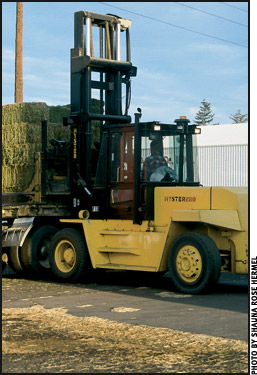Hay Producers: Be Aware of
Fire Ant Quarantine Rules
Fire ants often hitchhike in ag materials such as hay or nursery plants and infest new areas.
Arkansas producers selling a strong hay crop in a drought-driven market need to consider fire ant quarantine rules before shipping, according to the University of Arkansas Division of Agriculture and the Arkansas State Plant Board.
With Texas and other areas sustaining drought conditions, the market for Arkansas hay is robust. Fire ants, a danger to humans, livestock and electrical equipment, often hitchhike in agricultural materials such as hay or nursery plants and infest new areas.

Fire ants, a danger to humans, livestock and electrical equipment, often hitchhike in agricultural materials such as hay or nursery plants and infest new areas.
Terry Walker, director of the Plant Industry Division of the Arkansas State Plant Board, said if hay from Arkansas is shipped to a non-quarantined area, the hay recipient has to determine if the hay came from one of Arkansas' quarantined counties.
"We're trying to work with producers who are in non-quarantined areas shipping into non-quarantined areas," Walker said. "We've offered to send our inspectors out, and they will write a permit specifying that the hay originated in a non-quarantined county. That way the receiving area doesn't have to wonder.
"That's a pretty handy deal for the shipper not to have to fight that hassle, because sometimes the receiving state will say they don't want it, and the shipper will have to load it up and take it back," he said. "That's a big expense."
Shipping hay from fire ant quarantined areas is "not as big an issue this year as it was a couple of years ago when a lot of the hay was going to Tennessee and Kentucky," where there are no fire ants and shipping from infested states was a problem, said Kelly Loftin, extension entomologist and associate professor with the University of Arkansas Division of Agriculture.
Last week, Loftin issued an advisory about the fire ant quarantine to county agents in Arkansas.
"Whether it's an issue or not, it's still fresh on the minds of farmers and hay shippers, so that's why they're asking the county agents about shipping hay," he said.
As of January 2008, 33 of Arkansas' 75 counties are under quarantine and producers in those quarantined areas may not ship agricultural products to non-quarantined areas without meeting certain requirements outlined by the U.S. Department of Agriculture (USDA) Animal and Plant Health Inspection Service (APHIS).
Under quarantine as of January 2008 are: Ashley, Bradley, Calhoun, Chicot, Clark, Cleveland, Columbia, Dallas, Desha, Drew, Faulkner, Garland, Grant, Hempstead, Hot Spring, Howard, Jefferson, Lafayette, Lincoln, Little River, Lonoke, Miller, Montgomery, Nevada, Ouachita, Perry, Pike, Polk, Pulaski, Saline, Sevier, Union and Yell counties.
The Arkansas State Plant Board has established a "Protocol for Hay Movement in Relation to Imported Fire Ant Quarantine Requirements" to help hay producers prepare and ship their products according to those regulations.
Preventative measures
According to APHIS, there is no single treatment method that can remove all the imported fire ant colonies from hay while at the same time making sure the hay can't be re-infested.
Because hay is generally sold for livestock consumption, it can't be treated with insecticides that might offer that assurance, but there are ways producers can reduce the risk that their hay bales will become infested or that the infestations will spread.
Those preventive measures include:
• Putting a food source — a dab of peanut butter or a piece of sausage, for example — on a hay bale for an hour and then checking back to make sure no ants are present before shipping;
• Using high-pressure hoses to wash soil from support tires, wooden pallets and other shipping materials before loading the hay bales onto trucks;
• Elevating the hay bales off the ground by putting them on tires or wooden pallets to discourage ant colonies from moving in. Broadcast bait applications of approved insecticides can be used around the hay storage area.
Hay bales stacked on a second or higher level are not subject to regulations that restrict movement, Walker said.
 "Our interpretation of the regulation is that if it's not stored in direct contact with the soil, if it's a second layer up, then it is eligible for movement," he said. "Again, a shipper would be wise to get certified with a plant board inspector saying that it was not stored in direct contact with the soil."
"Our interpretation of the regulation is that if it's not stored in direct contact with the soil, if it's a second layer up, then it is eligible for movement," he said. "Again, a shipper would be wise to get certified with a plant board inspector saying that it was not stored in direct contact with the soil."
More information about fire ants can be found at http://www.aphis.usda.gov/plant_health/plant_pest_info/fireants/index.shtml
For a zip code locator of regulated areas, see http://www.aphis.usda.gov/plant_health/plant_pest_info/fireants/zipcode.shtml












